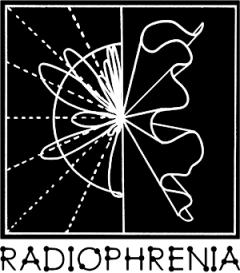 The switching off of the transmitter last Sunday at midnight marked the end of Radiophrenia 2016.
The switching off of the transmitter last Sunday at midnight marked the end of Radiophrenia 2016.
We now want to take this opportunity to thank everyone for their support in making this festival happen.
We’d like to thank:
Creative Scotland for funding such an unusual project.
All the staff at CCA for their support particularly Ainslie Roddick, Kenny Christie, all the tech staff and the (beyond the call of) Duty Managers.
All the commissioned artists, the live performers, those who came into the studio to perform, the hundreds of artists and producers whose work we broadcast, all our continuity announcers and everyone who responded to the open call.
Finally a huge thank you to all our listeners in Glasgow and in 39 countries around the world, and all those who tweeted, facebooked and wrote about us.
We welcome your feedback and comments on what we got right, what we could do better and which programmes and events were highlights.
If you’re going to miss the kind of work we broadcast we recommend tuning in to Radio Revolten. It’s a month long radio festival in Halle, Germany which has invited more than 70 artists from 17 countries to Halle am Saale to present 30 days of contemporary radio art in the form of performances, installations, concerts and live radio broadcasts. Radiophrenia will be there to represent Scotland and present the highlights of our broadcasts along with many of the artists whose work we’ve featured, including, Felix Kubin, The Resonance Radio Orchestra, Xentos Fray Bentos, Anna Friz and many more. Broadcasts begin on 1st October. Find out more at radiorevolten.net
The Radiophrenia schedule is also a goldmine of information about all the artists whose work we broadcast. We recommend investigating further, and you will discover links to many hours of innovative and exciting audio.
Keep an eye on our facebook and twitter feeds for news and audio.
Best wishes from the Radiophrenia team.
18th September 2016

 The switching off of the transmitter last Sunday at midnight marked the end of Radiophrenia 2016.
The switching off of the transmitter last Sunday at midnight marked the end of Radiophrenia 2016. At 11pm tonight we are featuring an 8 hour long recording of a live environmental installation, ‘Pollinator Synthesizer’, originally presented at Moogfest 2016.
At 11pm tonight we are featuring an 8 hour long recording of a live environmental installation, ‘Pollinator Synthesizer’, originally presented at Moogfest 2016. At 6.30pm this evening Aleks Kolkowski presents a new sound montage created especially for Radiophrenia: ‘The Bishop Sound Collection – Theatre & Radio Sound Effects on Lacquer Discs from the 1940s
At 6.30pm this evening Aleks Kolkowski presents a new sound montage created especially for Radiophrenia: ‘The Bishop Sound Collection – Theatre & Radio Sound Effects on Lacquer Discs from the 1940s  At 4pm today we have Paul Nataraj’s ‘You Sound Like a Broken Record’ – a practice led interrogation of the ontological resonances of vinyl record culture.
At 4pm today we have Paul Nataraj’s ‘You Sound Like a Broken Record’ – a practice led interrogation of the ontological resonances of vinyl record culture. At 4pm today musician, composer and Hörspiel producer Felix Kubin meets sound mechanic Neil Feather. Feather has been creating radical and unusual musical instruments since 1970 and is increasingly known as one of the most original musical thinkers of his day. His instruments each embody uniquely clever acoustic and engineering principles, and are visually arresting. The music he plays on the instruments is equally original, embodying new principles and resulting in a nearly alien idiom of music.
At 4pm today musician, composer and Hörspiel producer Felix Kubin meets sound mechanic Neil Feather. Feather has been creating radical and unusual musical instruments since 1970 and is increasingly known as one of the most original musical thinkers of his day. His instruments each embody uniquely clever acoustic and engineering principles, and are visually arresting. The music he plays on the instruments is equally original, embodying new principles and resulting in a nearly alien idiom of music. At 2pm today we have Ian Findlay-Walsh in the Radiophrenia studio with a live version of his piece ‘Ri Ri’. A performance/ live edit between field recordings and found recordings that document Rihanna’s July 2016 concert at Hampden Park in Glasgow.
At 2pm today we have Ian Findlay-Walsh in the Radiophrenia studio with a live version of his piece ‘Ri Ri’. A performance/ live edit between field recordings and found recordings that document Rihanna’s July 2016 concert at Hampden Park in Glasgow. Beginning tonight at midnight we have a special hourly chime created by Sarah Tripp and Nichola Scrutton.
Beginning tonight at midnight we have a special hourly chime created by Sarah Tripp and Nichola Scrutton.